

Principal, Education and Professional Development. Personal Learning Networks for Educators: 10 Tips - Getting Smart by Guest Author - edchat, EdTech, PLN. By Dr.
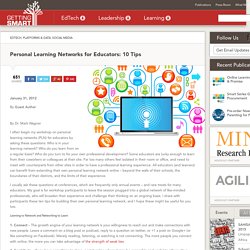
Mark Wagner. What is a Personal Learning Network? How to Create a Robust and Meaningful Personal Learning Network [PLN] This post describes how educators can develop a personal learning network that supports meaningful and relevant learning. The MOOC, Education Technology & Media, etmooc, is used here as a working example of how to develop a PLN. “My Personal Learning Network is the key to keeping me up-to-date with all the changes that are happening in education and how technology can best support and engage today’s students.” Brian Metcalfe: teacher, blogger at lifelonglearners.com.
5 Digital Forums to Transform Professional Learning for Educators. Are you ready to connect your professional learning to the modern era?
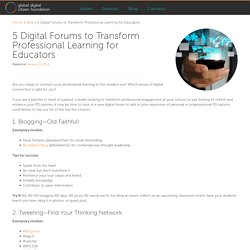
Which venue of digital connection is right for you? If you are a teacher in need of support, a leader looking to transform professional engagement at your school, or just looking to refresh and enhance your PD options, it may be time to look at a new digital forum to add to your repertoire of personal or organizational PD options. Look below to see our list of the top five choices. 1. Blogging—Old Faithful! Exemplary models Silvia Tolisano (@langwitches) for visual storytellingBo Adam’s Blog (@BoAdams1) for contemporary thought leadership Tips for success. 7 steps to creating PLCs teachers want to use.
PLN Explained By Will Richardson. 3 Steps for Building a Professional Learning Network - Education Week Teacher. Published Online: December 31, 2014 —Photo by Sean Chaffey, via Flickr Creative Commons By Brianna Crowley Recently, a colleague asked me, “What is a PLN?”
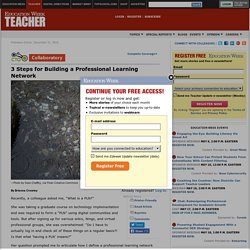
She was taking a graduate course on technology implementation and was required to form a “PLN” using digital communities and tools. But after signing up for various wikis, Nings, and virtual professional groups, she was overwhelmed: “Do I have to actually log in and check all of these things on a regular basis?! Professional Learning Networks - ISTE.
15 - PLN. Professional Learning Networks Professional learning networks (PLNs) give you the ability to stay in touch with great people, including experts in the field, colleagues, staff, or other school leaders.
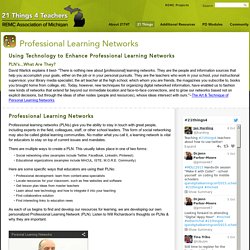
This form of social networking may also be called global learning communities. No matter what you call it, a learning network is vital for educators to stay on top of current issues and mandates. There are multiple ways to create a PLN. This usually takes place in one of two forms: Social networking sites (examples include Twitter, FaceBook, LinkedIn, Pinterest)Educational organizations (examples include MACUL, ISTE, M.O.R.E. Here are some specific ways that educators are using their PLNs: Develop your Professional Learning Network with Social Media. Building and Growing Your Professional Learning Network. As another Connected Educator Month draws to a close, it is important to understand the many benefits of being connected with like-minded individuals in the educational profession.
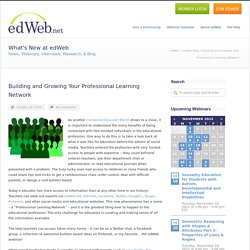
One way to do this is to take a look back at what it was like for educators before the advent of social media. Teachers entered the profession with very limited access to people with expertise – they could befriend veteran teachers, ask their department chair or administrator, or read educational journals when presented with a problem. The truly lucky ones had access to relatives or close friends who could share tips and tricks to get a rambunctious class under control, deal with difficult parents, or design a cool bulletin board.
Today’s educator has more access to information than at any other time in our history! Social media and schools as professional learning communities. Social media is burgeoning, and is not going to go away.

According to the Nielsen 3rd quarter report on the State of the Media; nearly four out of five active internet users now frequent social media sites. While there is a great deal of negative publicity surrounding social media, such sites can in fact be harnessed to create a myriad of possibilities for schools as learning communities. Well-known examples of social media include social networking site Facebook, microblogging tool Twitter, social bookmarking sites such as Delicious and Diigo, and common blogging platforms such as Wordpress and Blogger.
Each of these provides a different way of connecting and communicating with others via status updates, short comments, sharing of photos, useful web links or more extensive articles. Helping Educators Get Started With Twitter. The Teacher's Guide To Twitter. Twitter has proven itself to be an indispensable tool for educators around the globe.

Whatever skill level you may be, Twitter is downright fun and worth your time. So here’s a useful guide that we curated from Edudemic’s archives in an effort to put something together that was a bit easier to read than random blog posts. We hope you enjoy and will be regularly adding to this guide so feel free to leave your ideas down in the comments or by, what else, tweeting us @edudemic anytime! Eight Videos to Help Teachers Get Started Using Twitter. Building your PLN. Skip to content Building your PLN Know it or not, you already have some sort of Personal Learning Network or PLN!
It could be your colleagues, family, students, friends – whoever! But with the power of the web and online collaboration – a PLN could really grow! This series guides you step by step through the process of building your PLN. You can work through the activities in any order and at any time. 50 Terrific Twitter Tutorials for Teachers. Using Twitter in education has been all the buzz recently.

If you are ready to start using Twitter yourself and need a little help getting started or have already been using it and can use a little extra help, then these tutorials are just for you. An Educators Guide To Twitter. 10 popular MOOC instructors with brilliant Twitter accounts. Massive open online courses (MOOCs) may be a controversial topic in education right now, but everyone loves a good MOOC instructor.
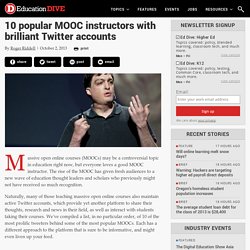
The rise of the MOOC has given fresh audiences to a new wave of education thought leaders and scholars who previously might not have received so much recognition. Naturally, many of those teaching massive open online courses also maintain active Twitter accounts, which provide yet another platform to share their thoughts, research and news in their field, as well as interact with students taking their courses. Brad Ovenell-Carter's Page. Step 2: Using Twitter to Build Your PLN. Welcome to the second step in our free professional learning series on building your PLN.

The aim of this step is to: Explain what is Twitter.Explain the benefits of using Twitter as part of your PLN.Helps you set up your Twitter account. This following information on Twitter was co-written by Kathleen Morris, a grade two teacher and blogger from Victoria, Australia. Kathleen writes a blog for educators about technology integration, educational blogging and global collaboration.
How To Get More Out Of Your PLN Using Twitter. So, you’ve made a Twitter account and are completely hooked. You’re following a bunch of people, companies, institutions… and if you walk away from Twitter for more than an hour, it seems like you can’t possibly keep up. While the constant stream of information is incredible, it is also overwhelming.
Too much to sift through? Doubting all the hype? @Ideas_Factory The blog of Julian S. Wood: Using Twitter & the PLN in Education. This work is licensed under a Creative Commons Attribution-NonCommercial-ShareAlike 3.0 Unported License. @Ideas_Factory The blog of Julian S. Wood. Privacy Policy for www.ideasfactory.me If you require any more information or have any questions about our privacy policy, please feel free to contact us by email at skyblue_jules@talk21.com. At www.ideasfactory.me, the privacy of our visitors is of extreme importance to us. Log Files Like many other Web sites, www.ideasfactory.me makes use of log files. Cookies and Web Beacons www.ideasfactory.me does not use cookies. DoubleClick DART Cookie .:: Google, as a third party vendor, uses cookies to serve ads on www.ideasfactory.me. .:: Google's use of the DART cookie enables it to serve ads to your users based on their visit to www.ideasfactory.me and other sites on the Internet. .:: Users may opt out of the use of the DART cookie by visiting the Google ad and content network privacy policy at the following URL -
Www.iceberg.org/professional_development/pln. How important is Twitter in your Personal Learning Network? Twitter and the Personal Learning Network (PLN). If you are a connected educator, chances are that you have often seen these two terms used together and, perhaps like me, you have wondered what's the connection?